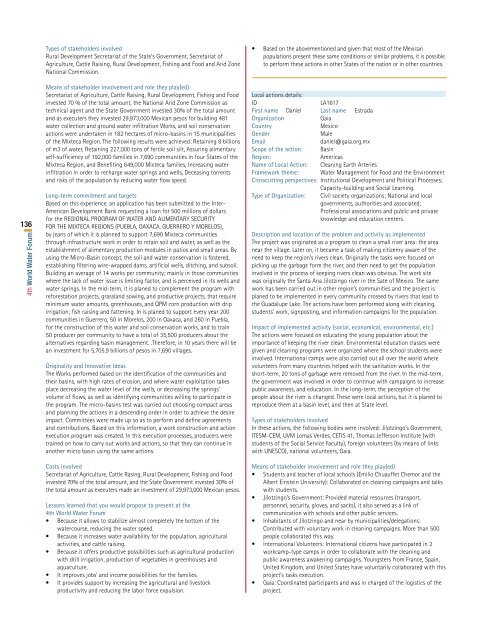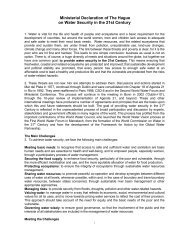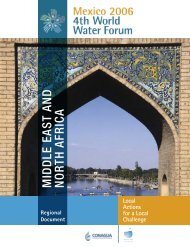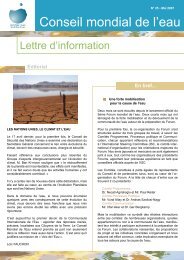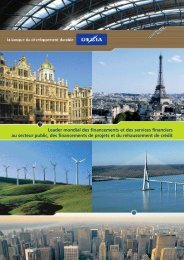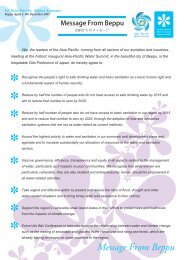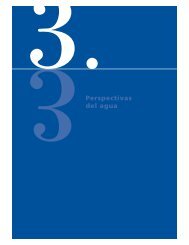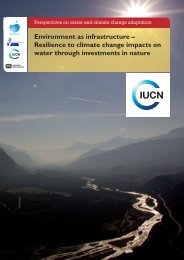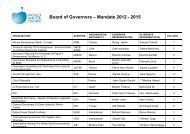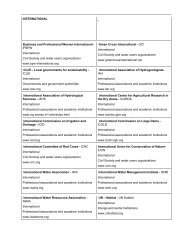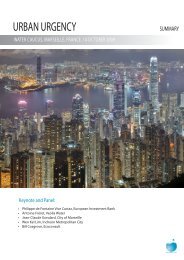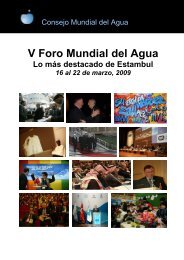Americas ok.indd - World Water Council
Americas ok.indd - World Water Council
Americas ok.indd - World Water Council
You also want an ePaper? Increase the reach of your titles
YUMPU automatically turns print PDFs into web optimized ePapers that Google loves.
Types of stakeholders involvedRural Development Secretariat of the State’s Government, Secretariat ofAgriculture, Cattle Raising, Rural Development, Fishing and Food and Arid ZoneNational Commission.• Based on the abovementioned and given that most of the Mexicanpopulations present these same conditions or similar problems, it is possibleto perform these actions in other States of the nation or in other countries.1364th <strong>World</strong> <strong>Water</strong> ForumMeans of stakeholder involvement and role they play(ed)Secretariat of Agriculture, Cattle Raising, Rural Development, Fishing and Foodinvested 70 % of the total amount, the National Arid Zone Commission astechnical agent and the State Government invested 30% of the total amountand as executers they invested 29,973,000 Mexican pesos for building 481water collection and ground water infiltration Works, and soil conservationactions were undertaken in 182 hectares of micro-basins in 15 municipalitiesof the Mixteca Region. The following results were achieved: Retaining 8 billionsof m3 of water, Retaining 227,000 tons of fertile soil silt, Assuring alimentaryself-sufficiency of 192,000 families in 7,690 communities in four States of theMixteca Region, and Benefiting 649,000 Mixteca families, Increasing waterinfiltration in order to recharge water springs and wells, Deceasing torrentsand risks of the population by reducing water flow speed.Long-term commitment and targetsBased on this experience, an application has been submitted to the Inter-American Development Bank requesting a loan for 500 millions of dollarsfor the REGIONAL PROGRAM OF WATER AND ALIMENTARY SECURITYFOR THE MIXTECA REGIONS (PUEBLA, OAXACA, GUERRERO Y MORELOS),by jeans of which it is planned to support 7,690 Mixteca communitiesthrough infrastructure work in order to retain soil and water, as well as theestablishment of alimentary production modules in patios and small areas. Byusing the Micro-Basin concept, the soil and water conservation is fostered,establishing filtering wire-wrapped dams, artificial wells, ditching, and subsoil.Building an average of 14 works per community; mainly in those communitieswhere the lack of water issue is limiting factor, and is perceived in its wells andwater springs. In the mid-term, it is planed to complement the program withreforestation projects, grassland sowing, and productive projects, that requireminimum water amounts, greenhouses, and QPM corn production with dripirrigation; fish raising and fattening. In is planed to support every year 200communities in Guerrero, 50 in Morelos, 200 in Oaxaca, and 260 in Puebla,for the construction of this water and soil conservation works, and to train50 producer per community to have a total of 35,500 producers about thealternatives regarding basin management. .Therefore, in 10 years there will bean investment for 5,705.9 billions of pesos in 7,690 villages.Originality and Innovative IdeasThe Works performed based on the identification of the communities andtheir basins, with high rates of erosion, and where water exploitation takesplace decreasing the water level of the wells, or decreasing the springs’volume of flows, as well as identifying communities willing to participate inthe program. The micro-basins test was carried out choosing compact areasand planning the actions in a descending order in order to achieve the desireimpact. Committees were made up so as to perform and define agreementsand contributions. Based on this information, a work construction and actionexecution program was created. In this execution processes, producers weretrained on how to carry out works and actions, so that they can continue inanother micro basin using the same actions.Local actions details:IDLA1617First name Daniel Last name EstradaOrganizationGaiaCountryMexicoGenderMaleEmaildaniel@gaia.org.mxScope of the action: BasinRegion:<strong>Americas</strong>Name of Local Action: Cleaning Earth ArteriesFramework theme: <strong>Water</strong> Management for Food and the EnvironmentCrosscutting perspectives: Institutional Development and Political Processes;Capacity-building and Social Learning.Type of Organization: Civil society organizations; National and localgovernments, authorities and associated;Professional associations and public and privateknowledge and education centers.Description and location of the problem and activity as implementedThe project was originated as a program to clean a small river area: the areanear the village. Later on, it became a task of making citizenry aware of theneed to keep the region’s rivers clean. Originally the tasks were focused onpicking up the garbage form the river, and then need to get the populationinvolved in the process of keeping rivers clean was obvious. The work sitewas originally the Santa Ana Jilotzingo river in the Sate of Mexico. The samework has been carried out in other region’s communities and the project isplaned to be implemented in every community crossed by rivers that lead tothe Guadalupe Lake. The actions have been performed along with cleaning,students’ work, signposting, and information campaigns for the population.Impact of implemented activity (social, economical, environmental, etc.)The actions were focused on educating the young population about theimportance of keeping the river clean. Environmental education classes weregiven and cleaning programs were organized where the school students wereinvolved. International camps were also carried out all over the world wherevolunteers from many countries helped with the sanitation works. In theshort-term, 20 tons of garbage were removed from the river. In the mid-term,the government was involved in order to continue with campaigns to increasepublic awareness, and education. In the long-term, the perception of thepeople about the river is changed. These were local actions, but it is planed toreproduce them at a basin level, and then at State level.Types of stakeholders involvedIn these actions, the following bodies were involved: Jilotzingo’s Government,ITESM-CEM, UVM Lomas Verdes, CETIS 41, Thomas Jefferson Institute (withstudents of the Social Service Faculty), foreign volunteers (by means of linkswith UNESCO), national volunteers, Gaia.Costs involvedSecretariat of Agriculture, Cattle Rasing, Rural Development, Fishing and Foodinvested 70% of the total amount, and the State Government invested 30% ofthe total amount as executers made an investment of 29,973,000 Mexican pesos.Lessons learned that you would propose to present at the4th <strong>World</strong> <strong>Water</strong> Forum• Because it allows to stabilize almost completely the bottom of thewatercourse, reducing the water speed.• Because it increases water availability for the population, agriculturalactivities, and cattle raising.• Because it offers productive possibilities such as agricultural productionwith drill irrigation, production of vegetables in greenhouses andaquaculture.• It improves jobs’ and income possibilities for the families.• It provides support by increasing the agricultural and livestockproductivity and reducing the labor force expulsion.Means of stakeholder involvement and role they play(ed)• Students and teacher of local schools (Emilio Chuayffet Chemor and theAlbert Einstein University): Collaborated on cleaning campaigns and talkswith students.• Jilotzingo’s Government: Provided material resources (transport,personnel, security, gloves, and sacks), it also served as a link ofcommunication with schools and other public services.• Inhabitants of Jilotzingo and near by municipalities/delegations:Contributed with voluntary work in cleaning campaigns. More than 500people collaborated this way.• International Volunteers: International citizens have participated in 2workcamp-type camps in order to collaborate with the cleaning andpublic awareness awakening campaigns. Youngsters from France, Spain,United Kingdom, and United States have voluntarily collaborated with thisproject’s tasks execution.• Gaia: Coordinated participants and was in charged of the logistics of theproject.


